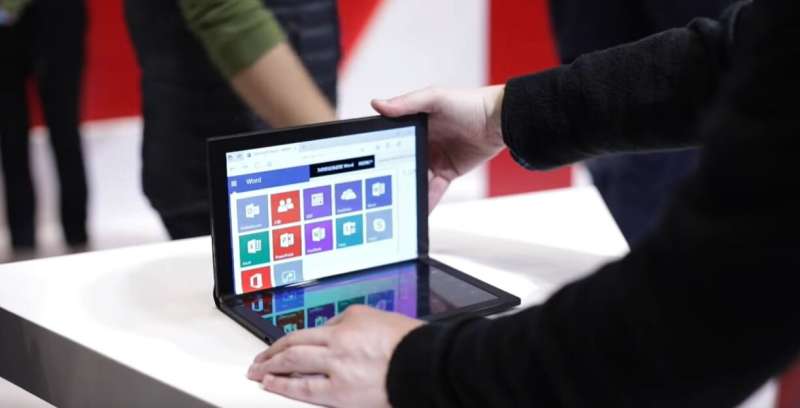January 8, 2020 weblog
Intel, Lenovo spread foldable computer fever at CES

Will more foldable and dual-screen PCs be more like the norm rather than the novelty? CES 2020 has shown promising signs that good things are coming down the pike.
Intel at CES showed off the concept of a foldable screen laptop code-named Horseshoe Bend. In doing so, Intel was posing the question, what if you took some of the technologies of the foldable phone and used them to solve some of the workflow issues on a PC?
It is a little laptop with a big screen, said reports—a 17-inch OLED screen that folds in half. The panels are covered in leather. CNET said the machine had a "premium leather exterior cover."
Just imagine, suggested tech watchers, a chip giant, not a specific hardware PC vendor, and it was bringing its own folding PC concept to Vegas. The Verge said it did so "with a view toward providing inspiration for an entirely new category of devices."
CNET's Patrick Holland, senior associate editor, said they tried out a prototype. Just don't confuse Intel and its prototype with a Lenovo. or any other PC vendor. "Intel made a recipe. But they did not make the meal." (Now it needs to get PC makers on board.)
Sam Byford in The Verge observed that "Intel really does seem to be pushing this form factor." He said it expected to be working with several manufacturers to help develop these devices in the future.
It is a PC, not just some re-imagined tablet. The Verge called it "A sleek 17-inch OLED monster." Byford relayed some specs. The OLED display is 4:3 and 17.3 inches diagonal when unfolded. He said it felt "much closer to a traditional laptop size when you fold it at an angle and use it on a desk. There's also a Surface-style kickstand so you can make use of the full display size when paired with a wireless keyboard."
Intel used a 17-inch foldable to show off its 'Tiger Lake' platform. It also showed the all-important hinge factor; in this Horseshoe Bend it used two hinges in parallel to connect the top and bottom parts.
What about Lenovo? There was plenty to report about its debut of a foldable display PC that, said New Atlas, tipped the scales at 2.2 lb including the cover.
Lenovo's ThinkPad X1 Fold was the subject of a HotHardware video.
New Atlas, meanwhile, talked about the partnerships that made this happen. The X1 Fold was in development for four years with LG Display, which provides the OLED screen. The device was also co-engineered with Intel, which will supply Intel Core Processors with Intel Hybrid Technology, and will come with 8 GB of RAM and an SSD offering up to 1 TB of capacity.
Darren Quick reporting for New Atlas had the details: 13.3-inch OLED touchscreen with a resolution of 2,048 x 1,536 at a ratio of 4:3.
If the physical keyboard is removed, you see an onscreen virtual keyboard or the unit can be unfolded with the physical keyboard used wirelessly. The device also supports connection of a full-size keyboard and mouse. A Bluetooth Mini Fold Keyboard is optional and it can be placed over the bottom half of the display.
Materials used include a leather folio cover (HotHardware commented that the leather cover was nicely integrated into the machine), lightweight alloys and carbon fiber, said Quick. The Windows 10 version is scheduled for release this year, said Quick.
Prices, reports said, start around $2,500.
"A Windows 10X version will come some time afterwards, as will an easel-like stand," said Quick.
With two big names showing foldables, there was bound to be attempts to make comparisons. In The Verge, Sam Byford said the Horseshoe Bend prototype's biggest difference with the X1 Fold "is, well, it's much bigger." Byford also commented that "Webpages feel like they scroll on forever; you can continue reading an article just by moving your hand away."
There was more to say on comparisons from The Verge: "Compared to the X1 Fold, Horseshoe Bend obviously doesn't have the fit and finish of a shipping device, but with its thinner bezels and slimmer profile, in some ways, it does feel sleeker. Of course, there's also something to be said for putting a much bigger slice of OLED in front of you."
BBC News looked at both big names at the show; the interviewer asked Intel's Chris Walker if they were annoyed about something. "So, Lenovo has unveiled its foldable at roughly the same time as you. Are you a bit annoyed that they've pipped you to the post?" Walker did not miss a beat. "Actually, we have done this in close collaboration with them. In fact, it's been that partnership with Lenovo over many years that's allowed the X1 fold at a smaller screen size to come to market."
Dell, meanwhile, showed CES attendees concepts. CNET reported on foldable Concept Ori and dual-screen Concept Duet.
Digital Trends said the concept names were not official. Luke Larsen, computer editor, said that with the devices Dell was trying to provide a preview of what devices they are looking forward to building in the future. "So, we don't know when these are coming or exactly what they will be like, but they do give us a pretty interesting idea of where Dell thinks the future is."
Concept Duet: Flip it to use horizontally and you can run a video chat on the top screen while taking notes on the bottom. Concept Ori: "The idea is you've got a full pen-enabled tablet PC that you can draw or write on, but which can also be used with a Bluetooth keyboard and mouse if you want. You can also fold it 90 degrees and use one half as an onscreen keyboard and the rest as your display."
© 2020 Science X Network




















